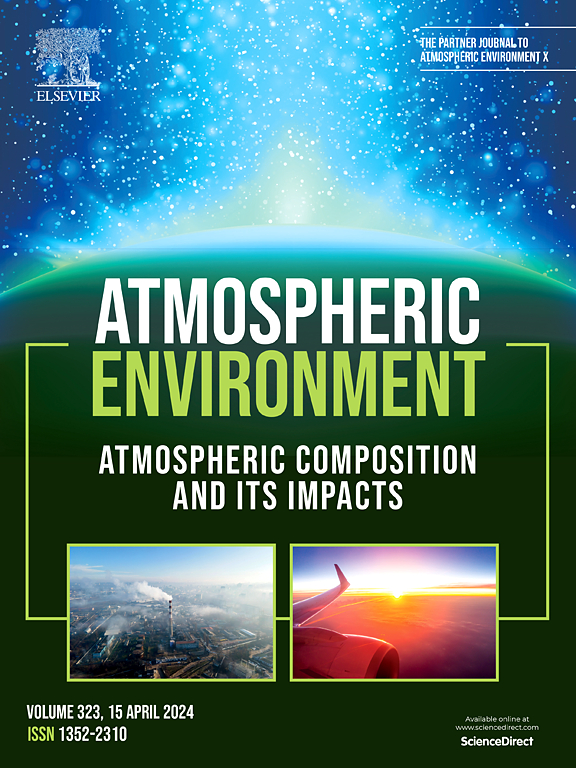Influence of atmospheric ammonia on secondary inorganic aerosol formation in PM2.5 during spring 2024 in the Hongseong area, Republic of Korea
IF 3.7
2区 环境科学与生态学
Q2 ENVIRONMENTAL SCIENCES
引用次数: 0
Abstract
Nitrate and organic components have been considered key contributors to high PM2.5 concentrations in Korea. This study examines the chemical evolution of aerosol species influenced by atmospheric ammonia (NH3) in Hongseong county, Chungcheongnam-do, Republic of Korea, during late spring 2024 (May 20 – June 18), a period characterized by intensive agricultural activity. Using an aerosol chemical speciation monitor and ammonia analyzer, an ammonium-rich atmospheric state (average NH3 concentration: 26.7 ± 12.4 ppb) was observed, with notable contributions from ammonium (NH4+), nitrate (NO3−), and sulfate (SO42−), especially under high-humidity conditions. The relative contributions of nitrate to PM2.5 for low (0–15 μg/m3), medium (16–30 μg/m3), and high (over 30 μg/m3) concentration intervals were 13.8 %, 23.4 %, and 29.6 %, respectively. Elevated relative humidity (RH), averaging 63.1 % (low), 82.3 % (medium), and 91.7 % (high), played a significant role in nitrate formation for those concentration intervals. Elevated nighttime ammonium conversion ratios (NHR) highlighted the importance of abundant atmospheric NH3 under high RH conditions, facilitating effective heterogeneous uptake and subsequent particulate ammonium formation. Source tracking using the conditional bivariate probability function (CBPF) model identified agricultural fields, power plants, and industrial complexes as major sources of precursor emissions. These results emphasize the need to control emissions of NH3, SO2, and NOx in rural areas to mitigate PM2.5 pollution and improve air quality.

2024年春季洪城地区大气氨对PM2.5中二次无机气溶胶形成的影响
硝酸盐和有机成分被认为是造成韩国PM2.5浓度高的主要原因。本研究考察了2024年春末(5月20日至6月18日)韩国忠清南道洪城县受大气氨(NH3)影响的气溶胶物种的化学演变,这一时期以集约农业活动为特征。利用气溶胶化学形态监测仪和氨分析仪,观察到大气中氨的富态(平均NH3浓度为26.7±12.4 ppb),其中铵(NH4+)、硝(NO3−)和硫酸盐(SO42−)的贡献显著,特别是在高湿条件下。低浓度区间(0 ~ 15 μg/m3)、中浓度区间(16 ~ 30 μg/m3)和高浓度区间(30 μg/m3以上)硝酸盐对PM2.5的相对贡献率分别为13.8%、23.4%和29.6%。相对湿度(RH)的升高,平均为63.1%(低)、82.3%(中)和91.7%(高),在这些浓度区间对硝酸盐的形成起着显著的作用。夜间氨转化率(NHR)的提高凸显了高相对湿度条件下丰富的大气NH3的重要性,促进了有效的非均质吸收和随后的颗粒铵形成。使用条件二元概率函数(CBPF)模型的源跟踪确定了农田,发电厂和工业综合体是前体排放的主要来源。这些结果强调了控制农村地区NH3、SO2和NOx排放以减轻PM2.5污染和改善空气质量的必要性。
本文章由计算机程序翻译,如有差异,请以英文原文为准。
求助全文
约1分钟内获得全文
求助全文
来源期刊

Atmospheric Environment
环境科学-环境科学
CiteScore
9.40
自引率
8.00%
发文量
458
审稿时长
53 days
期刊介绍:
Atmospheric Environment has an open access mirror journal Atmospheric Environment: X, sharing the same aims and scope, editorial team, submission system and rigorous peer review.
Atmospheric Environment is the international journal for scientists in different disciplines related to atmospheric composition and its impacts. The journal publishes scientific articles with atmospheric relevance of emissions and depositions of gaseous and particulate compounds, chemical processes and physical effects in the atmosphere, as well as impacts of the changing atmospheric composition on human health, air quality, climate change, and ecosystems.
 求助内容:
求助内容: 应助结果提醒方式:
应助结果提醒方式:


